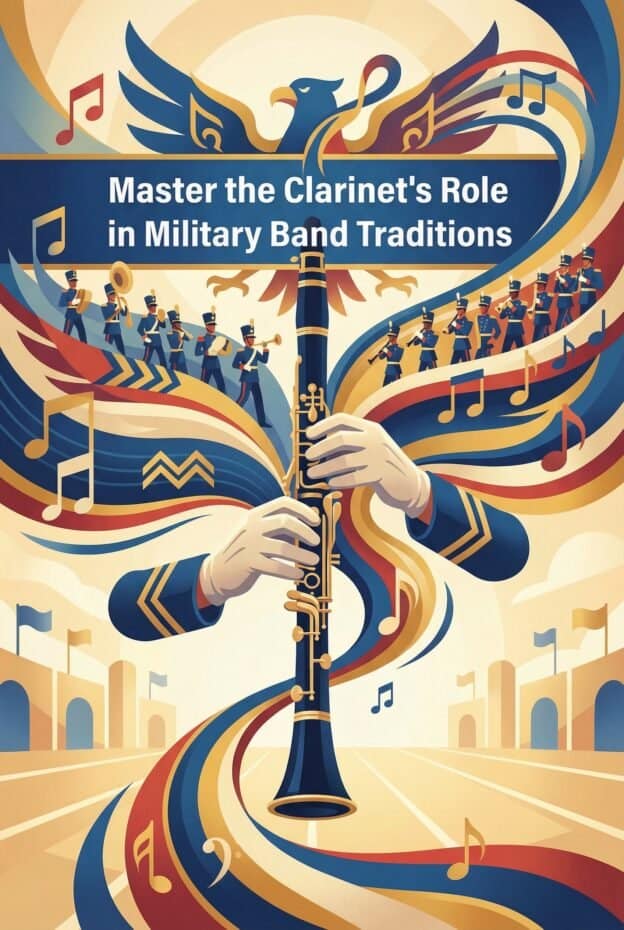The clarinet in military bands is a woodwind introduced in the late 1700s that added agile melody and rich tonal color to brass-and-percussion ensembles. From the 18th century onward, clarinets supported marches, ceremonies, and even limited battlefield communication, helping military bands project clear musical signals and expressive tunes in outdoor settings.
Clarinet and Military Bands: An Overview
The clarinet in military bands occupies a unique place between melody instrument and color voice. Its wide range, strong projection, and flexible tone allowed military ensembles to move beyond simple brass signals into fully scored music. By the 19th century, clarinets had become core voices in European and American regimental bands.
Military music historians often point to Prussian, Austrian, and French regiments as early adopters of clarinets in field bands. These ensembles used clarinets to double trumpet calls, carry countermelodies, and soften the edges of massed brass. Over time, clarinet sections expanded, and written parts grew more independent and virtuosic.
The instrument's role in military bands also shaped clarinet pedagogy. Band manuals, method books, and regimental bandbooks from the 19th century show a growing expectation that clarinetists read complex parts, project outdoors, and adapt to ceremonial, parade, and concert functions. This dual demand still defines clarinet work in modern military bands.
Timeline: From the Early 18th Century to the 20th Century
The clarinet emerged in the early 18th century from earlier chalumeau-type instruments, with makers in Nuremberg and other German centers refining the design. At first, its use was largely courtly and orchestral. Military adoption came later, as armies sought more varied and tuneful band sounds for parade and morale.
By the late 1700s, clarinets had entered several European military bands, especially in Prussia, Austria, and France. Regimental bandbooks from this period show parts labeled for clarino or clarinetto, often doubling or elaborating trumpet and oboe lines. The instrument's agility made it ideal for quick martial figurations and ornamented melodies.
During the early 19th century, clarinet use expanded across European armies and into the United States. As brass technology improved, bands grew louder, and clarinets were written in higher tessituras to cut through the ensemble. Composers like Hector Berlioz and later John Philip Sousa took advantage of this brighter, more penetrating clarinet sound in band arrangements.
In the late 19th and early 20th centuries, clarinet use in military bands stabilized. B-flat clarinets became the primary voice, with E-flat and bass clarinets as color instruments. The rise of professional military bands in the United States, Britain, and continental Europe led to more consistent instrumentation and more sophisticated clarinet writing.
By the mid-20th century, military bands absorbed stylistic elements from jazz and popular music. Clarinetists were expected not only to play traditional marches but also swing-influenced pieces, foxtrots, and film music arrangements. This stylistic breadth continues in modern service bands, which cover ceremonial, concert, and popular repertoire.
How Clarinets Were Used on the Battlefield and in Ceremonies
On the battlefield, clarinets had limited but notable roles. Drums, bugles, and trumpets carried primary signal duties because of their piercing sound and simple patterns. However, some 18th and early 19th century accounts describe clarinets reinforcing signal calls, especially in camp, on the march, or during formal troop movements near the lines.
In many armies, clarinets were more active in pre-battle and post-battle functions. They played during troop assemblies, reviews, and marches to the front. Military manuals from Britain, France, and Prussia describe bands leading columns with marches that boosted morale and regulated marching pace, with clarinets carrying key melodic lines.
Ceremonial use was far broader. Clarinet sections supported national anthems, regimental marches, and slow ceremonial pieces for funerals, parades, and diplomatic events. Their flexible dynamic range allowed them to blend with brass for powerful climaxes, then drop to soft, expressive lines for memorial services or religious observances.
In garrison life, clarinets also served in social and dance music. Regimental bands often provided music for officers' balls and civic events. Period dance collections and band arrangements show clarinet lines adapted to waltzes, polkas, and quadrilles, a reminder that military bands functioned as both martial and community ensembles.
Roles and Functions in Military Ensembles (marches, melodies, color)
Within the military band, clarinets fulfill three main functions: carrying primary melodies, providing inner harmonic voices, and adding tonal color. In classic European and American marches, the first B-flat clarinet often doubles or ornaments the main tune, sometimes in octaves with cornets or trumpets for extra brilliance.
Second and third clarinet parts usually fill harmonic and rhythmic roles. They support the inner voices between high brass and low saxophones or horns, reinforcing chords and rhythmic figures. This inner texture helps balance the band sound so that trumpets and trombones do not dominate the ensemble in outdoor spaces.
E-flat clarinet and bass clarinet add distinctive color. The E-flat clarinet can project shrill fanfare-like figures above the band, useful in open-air parades. Bass clarinet deepens the woodwind choir, tying clarinet lines to low brass and percussion. Many 20th-century military band scores use bass clarinet to anchor woodwind harmonies in marches and concert works.
Clarinet agility also supports ceremonial solos and obbligato lines. In slow marches, hymns, or memorial pieces, solo clarinet can float expressive melodies over sustained brass chords. This role demands strong control of tone and intonation, especially outdoors, where wind and temperature can destabilize the sound.
Instrument Design and Key Improvements (Theobald Boehm and playability)
Clarinet design changes directly affected what military bands could ask of their players. Early 18th-century clarinets had few keys and limited chromatic facility, which restricted parts to simpler tonalities. As more keys were added during the late 18th and early 19th centuries, clarinetists could handle more complex marches and ceremonial pieces in varied keys.
Theobald Boehm is best known for his work on the flute, but his ideas on key placement and acoustics influenced clarinet makers in the 19th century. Boehm-style systems inspired more rational keywork, more even fingerings, and better intonation. These improvements made fast, chromatic clarinet parts in military bands more reliable and accessible to trained players.
For military use, three aspects of clarinet anatomy mattered most: range, projection, and tone color. The cylindrical bore and single reed gave clarinets a strong, focused sound that could cut through outdoor noise. Expanded keywork extended the usable range upward, allowing clarinets to sit above mid-brass and be heard clearly on parade grounds.
Modern B-flat clarinets with Boehm-derived key systems offer consistent fingering patterns across registers, which helps band clarinetists switch quickly between march tempos and lyrical ceremonial passages. Improved pad materials and key mechanisms also reduce mechanical noise, important when clarinets play soft lines under exposed brass solos.
Current discussions of military band clarinets often overlook specific instrument types. Historical sources show frequent use of B-flat and E-flat clarinets in bands, with A clarinets more common in orchestral settings. Band setups also favored durable materials and strong keywork that could withstand travel, weather, and frequent outdoor performance.
Clarinet types and typical military-band setups
In 19th-century military bands, B-flat clarinets formed the core section. E-flat clarinets added brilliance for outdoor projection, while alto and bass clarinets appeared in larger or more advanced ensembles. Some European regiments experimented with C clarinets, but B-flat instruments gradually dominated because of their balance of tone and tuning stability.
Today, most military bands standardize on B-flat clarinets with Boehm-system keywork. Many use hard rubber or composite bodies for durability in varied climates, reserving grenadilla instruments for concert work. Key plating and pad materials are chosen for resistance to corrosion and moisture, critical for players who perform in rain, heat, or cold.
For educational and historical writing, adding diagrams of B-flat, E-flat, and bass clarinets, along with cutaway views of bore and tone hole placement, can help readers understand why these instruments respond differently outdoors. Acoustic characteristics such as brighter timbre in E-flat clarinet or darker resonance in bass clarinet directly shape military band scoring choices.
19th-Century Repertoire Development and Composers Writing for Bands
During the 19th century, clarinet parts in military band repertoire grew more independent and expressive. Composers and bandmasters across Europe and the United States began to write specifically for clarinet sections rather than treating them as simple doublers of oboes or trumpets. This shift is visible in surviving regimental bandbooks and published band scores.
In France, composers associated with the Garde Républicaine and other elite bands wrote clarinet lines that exploited the instrument's singing upper register. In Prussia and Austria, military bandmasters adapted opera excerpts and orchestral works, often assigning key vocal or violin melodies to clarinets. These arrangements helped train band clarinetists to phrase like singers.
In the United States, John Philip Sousa and his contemporaries wrote marches where clarinets often carry the primary tune or intricate countermelodies. Works like “The Stars and Stripes Forever” showcase clarinet agility in rapid passages that weave around brass lines. This style set a template for later American military and school band writing.
Band repertoire also expanded beyond marches. 19th-century military bands played overtures, waltzes, and potpourri arrangements of popular opera tunes. Clarinetists were expected to adapt quickly from staccato march articulation to legato lyrical styles. Surviving scores and parts in archives such as the Library of Congress and national military museums document this broad functional repertoire.
Arranging guidance for modern band directors
For directors arranging or adapting 19th-century material, clarinet sections can safely take over many violin and high woodwind lines from orchestral sources. When transcribing, keep clarinet parts within comfortable marching ranges, usually from written low E to high C or D, to maintain projection and intonation stability in outdoor conditions.
Directors can also use clarinets to bridge between trumpets and saxophones in modern concert-style arrangements. Doubling inner lines at the unison or octave with clarinets helps stabilize pitch and adds warmth without sacrificing clarity. This approach echoes 19th-century bandmasters who relied on clarinets to glue together diverse instrument families.
Standardization and 20th-Century Trends (including jazz influence)
The 20th century brought greater standardization to military band instrumentation. Published scoring guides and official tables of organization in countries like the United States, United Kingdom, and Germany specified numbers of clarinets and their roles. B-flat clarinets became the default, with E-flat and bass clarinets as auxiliary voices in larger or premier ensembles.
World War I and World War II accelerated this standardization, as armies needed interchangeable parts and consistent training. Clarinet method books used in military schools aligned with Boehm-system fingerings, and repair facilities were organized to support common models. This consistency allowed clarinetists to move between units and still read standard band parts.
Jazz influence entered military bands through swing and dance music in the early to mid-20th century. Clarinetists in some service bands played both traditional march repertoire and jazz-influenced pieces, sometimes even improvising short solos in concert programs. The popularity of clarinetists like Benny Goodman and Artie Shaw encouraged band arrangers to feature clarinet lines with swing phrasing and blue notes.
After mid-century, saxophones took over many jazz roles in military bands, but clarinets remained important for stylistic flexibility. Modern military band programs often include big band subsets, where clarinet doubles or lead parts appear, especially in clarinet-saxophone doublings. This cross-genre expectation shapes clarinet training for service musicians today.
Player outcomes in modern military bands
For clarinetists, 20th-century trends created clear performance outcomes. Players must project confidently in outdoor ceremonies, blend smoothly with brass in concert halls, and adapt to jazz-influenced articulations when required. Directors measure success by the section's ability to lead melodic lines in parades and maintain balance with powerful brass and percussion.
Clarinetists who master these demands gain strong ensemble skills that transfer to civilian wind bands, orchestras, and chamber groups. The discipline of military band work, with its frequent performances and varied repertoire, often accelerates technical and musical development compared with less intensive ensembles.
Field-Oriented Maintenance for Military and Marching Use
Military and marching band clarinetists face harsher conditions than typical indoor players. Dust, moisture, temperature swings, and frequent travel all stress the instrument. A clear, field-oriented maintenance routine keeps clarinets reliable for parades, ceremonies, and long outdoor events where repair access may be limited.
Swab the bore thoroughly after every rehearsal or performance, especially outdoors. Use a pull-through swab that will not snag on tone holes, and avoid leaving moisture inside the instrument, which can swell pads and crack wooden bodies. In very humid or rainy conditions, swab during breaks as well as at the end of playing.
Reed rotation is important for reliability. Keep at least 4 to 6 playable reeds in a ventilated reed case, and mark them by number or date. Rotate reeds from piece to piece or day to day so that no single reed bears all the stress of outdoor use. This practice reduces sudden reed failures during ceremonies.
Basic key care includes gently wiping moisture from key surfaces and pads with a clean, lint-free cloth. Apply small amounts of key oil to pivot points when needed, but avoid over-oiling, which can attract dust. Check screws and rods regularly, especially after travel, as vibration can loosen them and cause noisy keys.
For transport, use a sturdy case with secure latches and interior padding. When traveling with a unit, label cases clearly and avoid stacking heavy items on top. In cold weather, let the clarinet warm gradually before playing to reduce the risk of cracking. In hot sun, shade the instrument whenever possible to protect pads and corks.
Troubleshooting Common Military Band Clarinet Problems
Outdoor performance introduces predictable clarinet problems: projection issues against brass, reed instability, and intonation drift. Clarinetists and directors who anticipate these challenges can apply simple fixes on site, keeping ceremonies and parades running smoothly without long delays or emergency repairs.
Projection against brass starts with articulation and voicing. Encourage players to use a slightly firmer articulation and more focused air stream in marches. Raising the tongue position inside the mouth (as if saying “ee”) can brighten the tone and help it carry. Avoid overblowing, which can spread the sound and worsen intonation.
Humidity and temperature swings often cause reeds to go flat or unresponsive. If a reed feels waterlogged, gently blot it with clean paper and let it rest while switching to another reed from the rotation. Slightly stronger reeds may perform better in hot, humid conditions where softer reeds collapse under air pressure.
Intonation drift during long ceremonies is common, especially when instruments warm up or cool down unevenly. Clarinetists should learn to adjust barrel position quickly and use alternate fingerings to correct sharp or flat notes. Directors can schedule brief tuning checks between pieces when protocol allows, especially in extreme weather.
Each clarinetist should carry a small field repair kit: a precision screwdriver, spare ligature, extra reeds, cork grease, and a small piece of Teflon tape or paper for emergency pad shims. While serious repairs belong to technicians, these simple tools can resolve loose screws, slipping ligatures, and minor leaks long enough to finish an event.
Research Gaps, Archives, and Further Reading
The history of clarinet use in military bands is rich but unevenly documented. Many surviving accounts focus on famous composers or elite ensembles, while everyday regimental practices remain scattered across archives. Researchers often must piece together evidence from bandbooks, pay records, and military manuals to reconstruct clarinet roles in specific units.
Key research gaps include detailed timelines of clarinet adoption in individual armies, documentation of specific clarinet models issued to regiments, and first-hand accounts from rank-and-file band clarinetists. Few studies systematically compare clarinet parts across different national band traditions, leaving questions about stylistic differences between, for example, French and British military clarinet writing.
Valuable sources include the Library of Congress band music collections, the Smithsonian Institution's musical instrument archives, and national military museums in countries such as France, Germany, and the United Kingdom. Many hold original band scores, part books, and period method books that reveal how clarinet technique and scoring evolved in military contexts.
Future research could benefit from digitized regimental bandbooks with searchable clarinet parts, allowing quantitative analysis of range, key usage, and technical demands over time. Comparative studies between orchestral and military clarinet writing in the same period would also clarify how field requirements shaped distinct performance traditions.
Key Takeaways
- The clarinet entered European military bands in the late 1700s and became a core melodic and color voice by the 19th century.
- Design improvements influenced by Theobald Boehm's ideas made clarinet parts more agile, chromatic, and reliable for outdoor military use.
- Field-oriented maintenance, reed management, and simple troubleshooting are important for clarinetists performing in military and marching settings.
- 20th-century standardization and jazz influence expanded clarinet roles, requiring players to adapt from traditional marches to swing-influenced repertoire.
- Significant research opportunities remain in archival bandbooks and military records to map clarinet use across different nations and regiments.
FAQ
What is clarinet in military bands?
Clarinet in military bands refers to the use of clarinet families, primarily B-flat clarinets, within organized military ensembles for marches, ceremonies, concerts, and, historically, limited signaling. Clarinets provide agile melodies, inner harmonies, and tonal color that balance powerful brass and percussion in outdoor and ceremonial settings.
How did the clarinet become part of military bands?
The clarinet entered military bands in Europe in the late 18th century, as armies sought more tuneful and flexible band sounds than brass and drums alone could offer. Regimental bandbooks from Prussia, Austria, and France show clarinet parts gradually expanding from simple doublings to independent melodic and harmonic roles.
Which clarinet types were commonly used in 19th-century military bands?
In 19th-century military bands, B-flat clarinets were the primary instruments, often in multiple parts. E-flat clarinets added brilliance and projection, especially outdoors. Some larger or elite bands also used alto and bass clarinets, while A clarinets were more typical in orchestral than military settings.
How were clarinets used for battlefield communication?
Clarinets played a secondary role in battlefield communication compared with drums, bugles, and trumpets. In some 18th and early 19th century contexts, they reinforced or elaborated signal calls in camp or on the march. Their main contribution, however, was in pre-battle marches, troop movements, and morale-boosting music rather than direct tactical signaling.
What maintenance should clarinetists follow when performing outdoors or on parade?
Clarinetists performing outdoors should swab the instrument after each use, rotate 4 to 6 reeds stored in a ventilated case, wipe keys and pads gently, and check screws and rods regularly. Use a sturdy case for transport, protect the instrument from extreme temperatures, and carry basic supplies such as cork grease, spare reeds, and a small screwdriver.
Who was Theobald Boehm and how did his improvements affect clarinet performance in bands?
Theobald Boehm was a 19th-century flutist and instrument designer whose keywork and acoustic ideas transformed flute construction. Clarinet makers adapted similar principles to clarinet key systems, leading to more logical fingerings, better intonation, and greater technical facility. These improvements allowed military band clarinetists to play more complex, chromatic parts with greater reliability.







